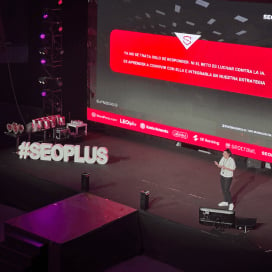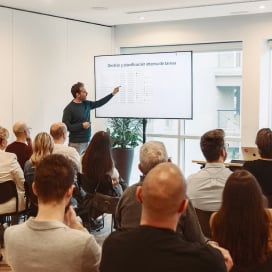Written by Ian Canet
Index
On March 5, Google introduced AI Mode in the United States. Although it’s still in beta, AI Mode aims to offer a conversational search experience that competes with ChatGPT, Perplexity, and others.
In Europe, we have stricter regulations regarding data privacy and artificial intelligence, so it’s still uncertain when it will arrive in countries like Spain.
Fortunately, at Human Level we have access to the AI Mode trial and have been conducting numerous experiments. Among all the sectors and types of searches we’ve tested, local searches have yielded results that differ from what we’re currently used to. In this article, we’ll share the main differences we’ve identified and offer some recommendations to help prepare your local business for the arrival of Google AI Mode.
What results do we see in AI Mode?
To observe how Google AI Mode behaves in local search, we used various types of local businesses and services as reference. However, for this analysis, we’ll focus on searches related to hospitality:
- Searches without geographic modifier: “best pizzerias”
2. Searches with geographic modifier: “best pizzerias in Minneapolis”
3. “Near me” searches, which are widely used by users, especially in Maps.
It’s important to note that this analysis was conducted during the last week of May, so the results may change in the future (remember, it’s still in beta).
Generally, across all these types of searches, we encounter a list of Google Business Profile listings, categorized based on criteria the AI deems appropriate for the user depending on the context of the query: by type of venue, city, proximity, distinction between top-rated and other businesses that might be of interest, etc.
The first thing that stands out is that the traditional Local Pack view disappears in AI Mode results. This is surprising, as we’re used to seeing an interactive map with three highlighted results in a prominent position. Darren Shaw also noted this in his LinkedIn post. Here, the interactive map appears at the end of the response.
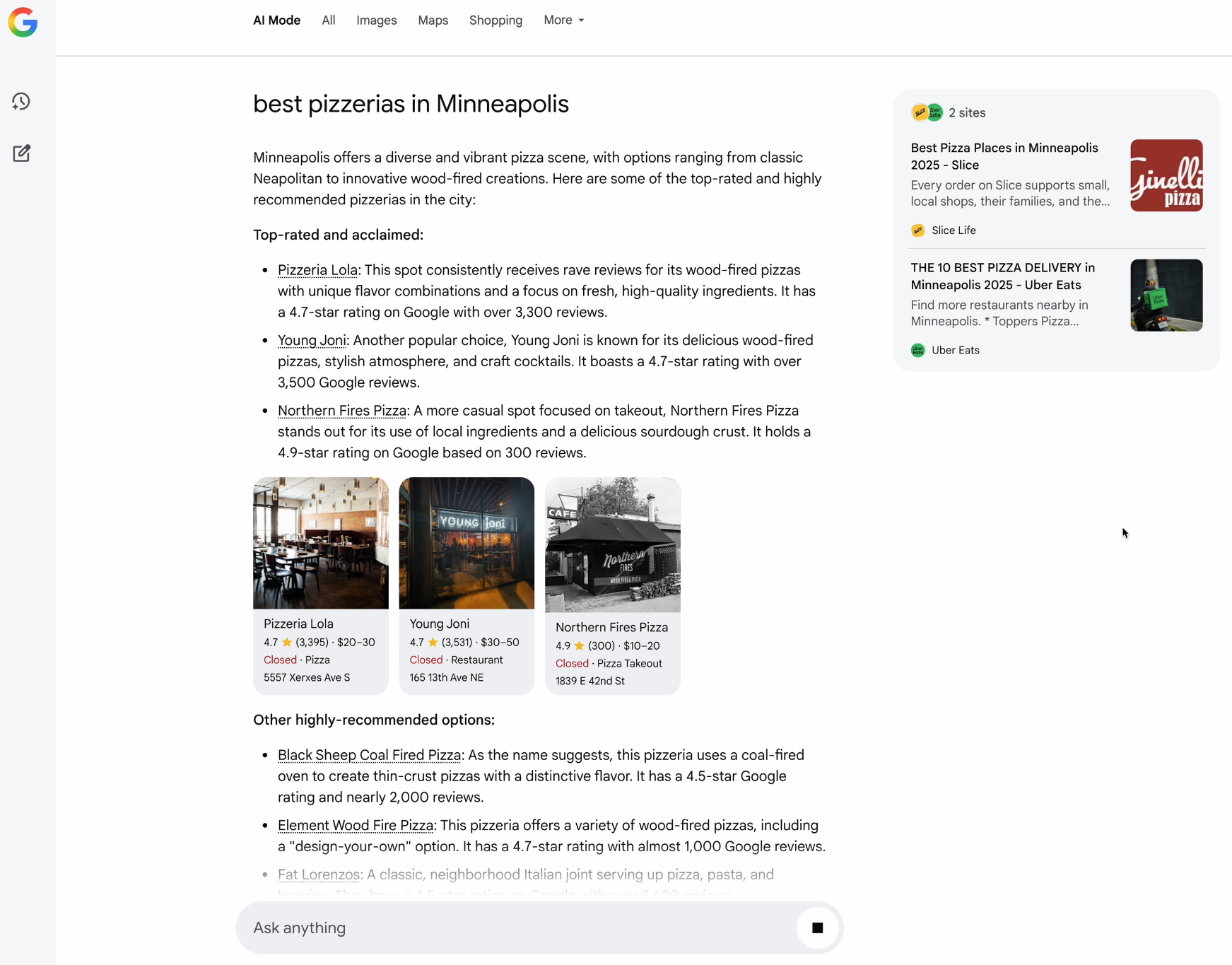
We see the right-hand panel listing the sources used to generate the response, similar to the AI Overviews in Google Search.
The response includes a brief description of each business listed, tailored to the context. For instance, if it’s showing top-rated businesses in the area, it explains what sets them apart and includes their rating (taken from GBP):
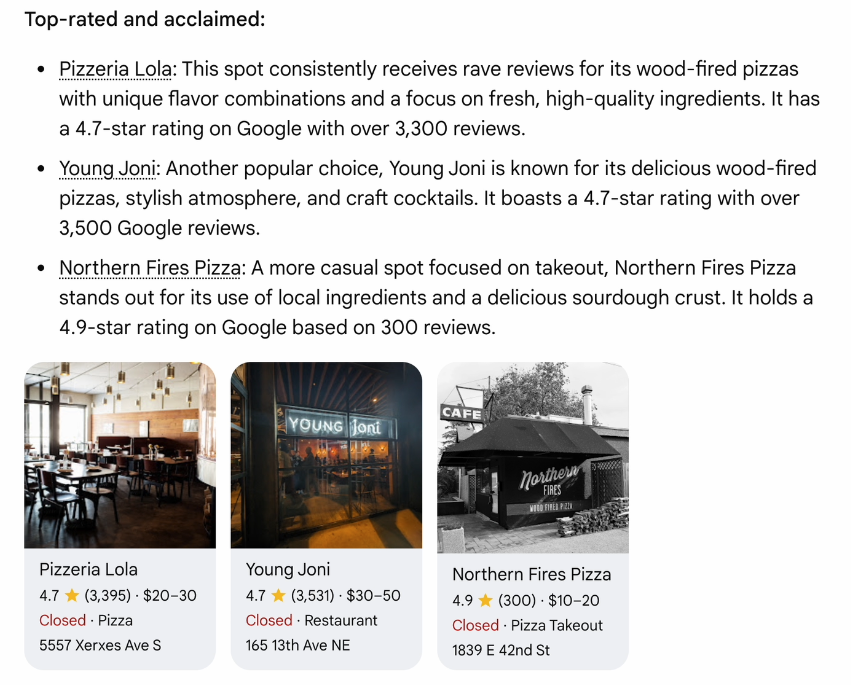
Sometimes, the list of recommended businesses is much longer than in traditional Google results. While the current Google results typically show a Local Pack with three highlighted businesses (and occasionally a second Local Pack at the bottom in Europe), in AI Mode we’ve seen lists with up to ten businesses.
The top three businesses that usually appear in the Local Pack also show up in AI Mode, reinforcing the importance of a well-optimized Google Business Profile to increase your chances of appearing in AI Mode:

An interactive map is also shown at the end of the response, listing the businesses selected by the AI. You can browse the map, and clicking on any business opens the Google Business Profile view, allowing interaction just like in the current version. Additionally, clicking on any business name or link in the response opens the same right-hand panel:
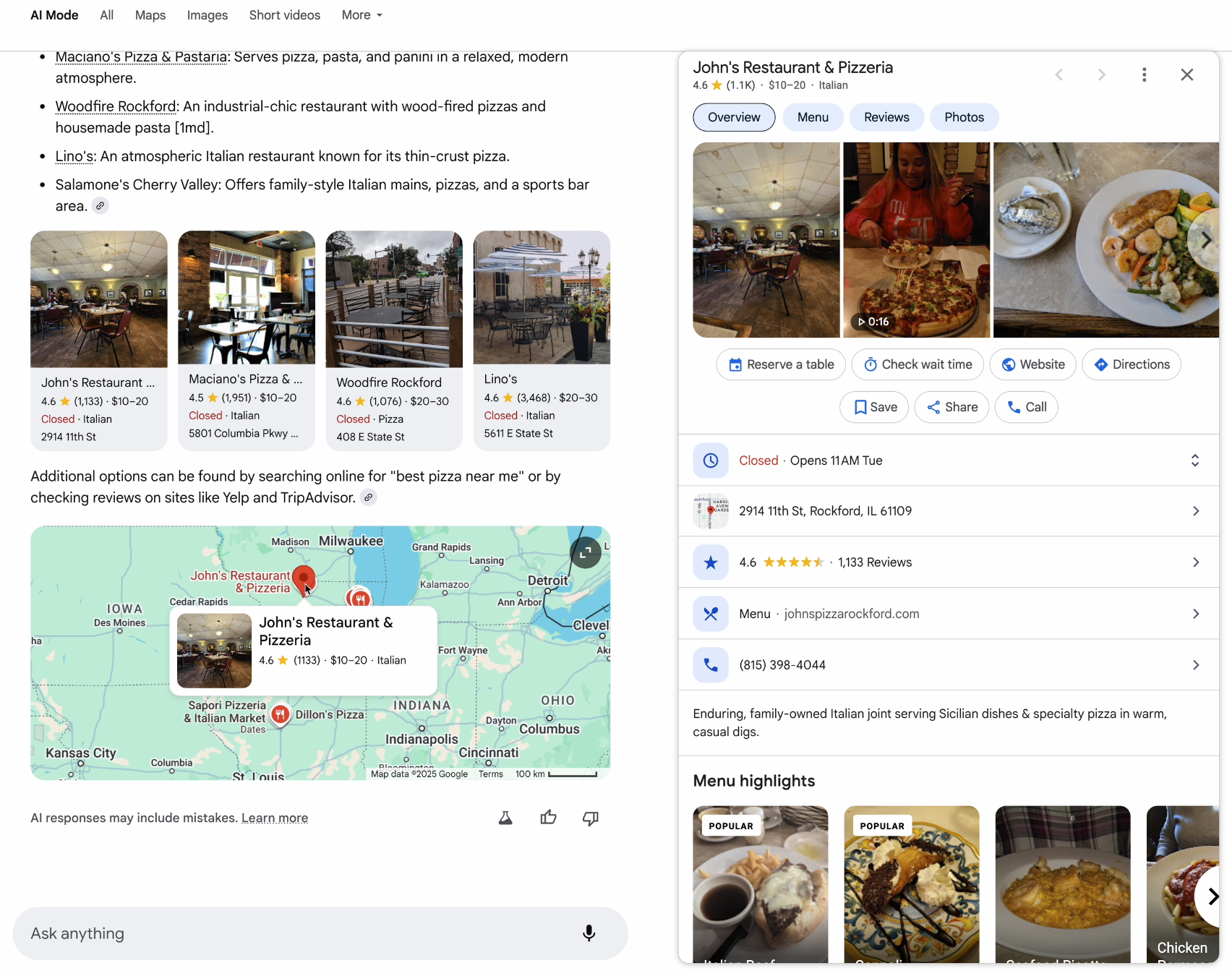
Does proximity influence the results?
Like any analytical and curious mind, we wondered whether Google considers proximity when presenting a list of businesses and the interactive map at the end of the response.
We see that, depending on the context of the query and location, the response and map adjust accordingly. Therefore, Google is taking device location into account to show nearby local results.
For example, in the search “best pizzerias” with geolocation in Chicago, it returns a list and map focused entirely on Chicago. On the other hand, using the “near me” modifier, Google offers a wider variety of businesses not only from your location but also nearby areas.
If the query includes a geographic modifier from another city, the results, as expected, are located in the requested city.
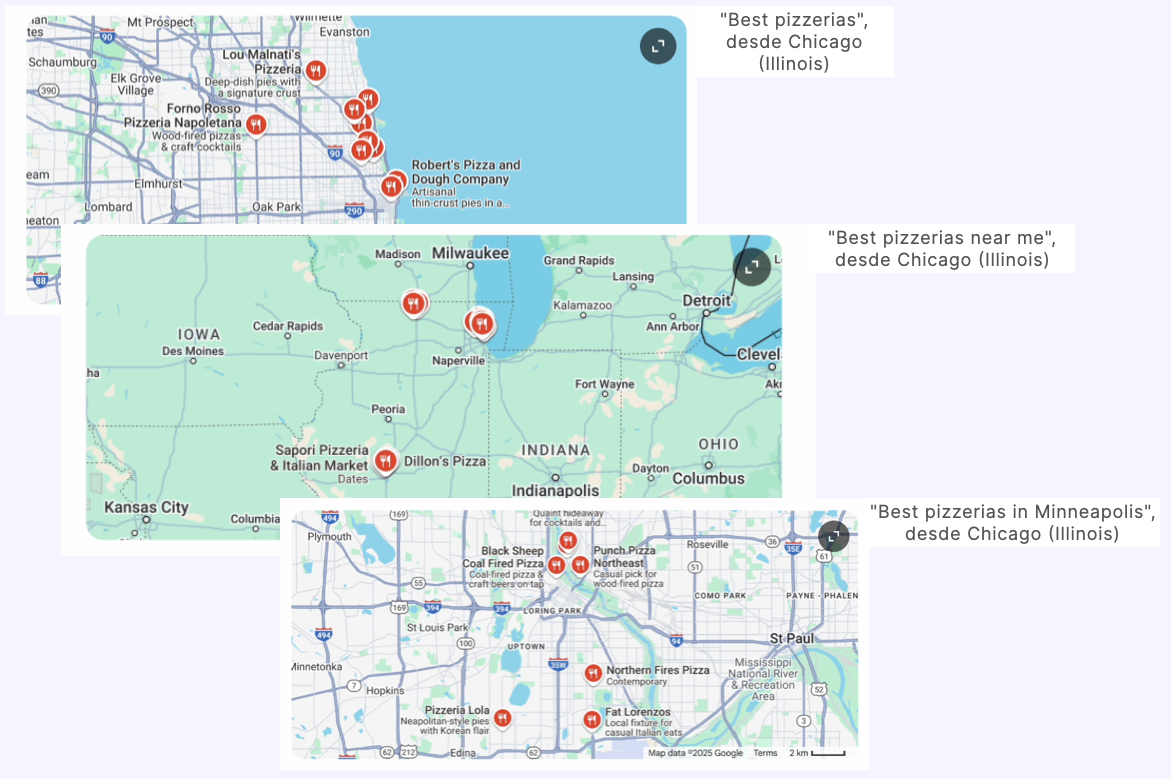
For a more in-depth analysis of how exact location and proximity affect the ranking of listed results, we’ll wait to conduct tests on mobile devices, where geolocation plays a greater role.
To recap
In summary, local intent queries show a greater presence of Google Business Profile listings compared to traditional SERPs. Geolocation and proximity remain key factors that Google uses to generate responses in AI Mode.
This presents a great opportunity for businesses that weren’t able to rank in the top three and therefore didn’t appear in the Local Pack (remember, only a small percentage clicked the “More places” button).
What can we do to get listed in AI Mode?
We must understand that AI Mode allows users to make complex, conversational searches like: “recommend restaurants in Madrid that are open next Sunday, have air-conditioned indoor seating so I don’t get too hot, and allow dogs.”
SEO thinking in terms of keywords is becoming more complex, as expected. On both our local business websites and Google Business Profiles, we must focus on three main optimization areas: Relevance, Popularity, and Proximity.
Relevance
Relevance indicates how closely aligned and pertinent a local business is to a particular search query. The more affinity it shows and the better it meets the user’s needs, the higher the chances the brand will be displayed in search results. For example, a user searching for “dental clinic near me” is not interested in seeing results for law firms.
Working on relevance properly might seem easy, but we often overlook certain sections of our website or Business Profile listings and miss out on opportunities to improve the brand’s optimization. That’s why we should focus on the following areas to help Google better understand what our business is about.
Google Business Profile
- Start by choosing a primary category that is as accurate as possible, along with secondary categories that fit what you offer.
- The listing title is important and greatly helps organic positioning. However, you must be careful and avoid keyword stuffing.
- The business description also matters. It’s a great place to introduce yourself and showcase your value proposition. What’s your story? What sets you apart from the competition? Always remember to display your contact information consistently — that way, you keep your NAPW (Name, Address, Phone, Website) up to date!
- Filling out the services and products section will also help Google better understand what you offer and when to display you to users searching for your services.
- Keep your business hours updated. For example, is there a specific day you’re closed? If so, indicate it in the special hours section. Nothing motivates a user to leave a negative review more than showing up to a closed business.
- Keep your image and video repository active and well-stocked. We know Google can recognize what’s in an image and categorize them accordingly, so it will better understand what you do or offer if you provide original and high-quality images.
- Maintain a steady flow of high-quality reviews. Reviews are a key factor in user conversion and retention on your listing, and they are strong positive signals for your organic positioning. Ask satisfied customers to leave a review, mention your brand or service/product, and include photos or videos.
- Business attributes are more important than ever, as this is where we tell Google directly if our restaurant, for example, has a terrace or a wheelchair-accessible entrance.
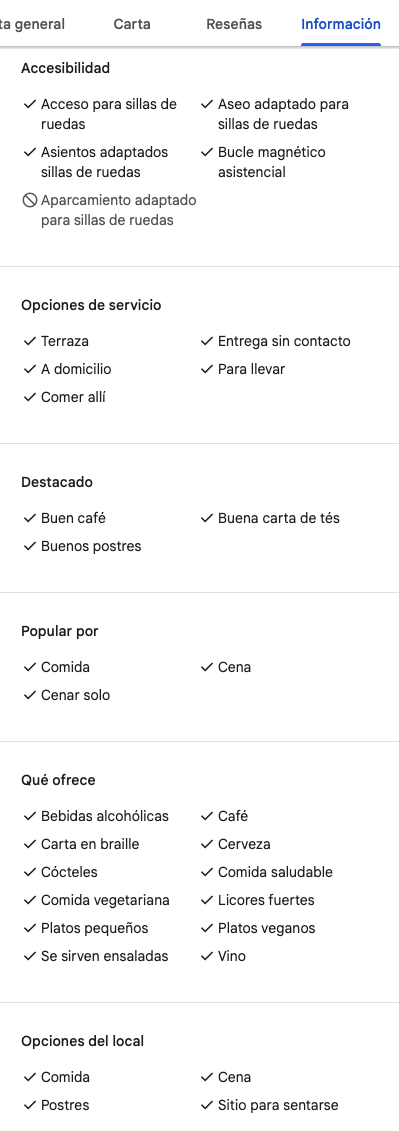
- Post regularly and let users know about upcoming weekend offers at your business. An active listing with consistent posts shows Google that it’s a reliable and up-to-date business.
- Regarding the Questions & Answers section, there’s some uncertainty in the industry. It’s unclear whether Google will phase it out in favor of an AI-powered feature. Our recommendation is to take advantage of it now by posting and answering the most common questions from your customers, if it’s still visible in your listing.
Website
- Your entire website should include correct and up-to-date information about your business and its locations, aligned with the details in your Business Profile listing and any directories you are listed in. The website is a valuable information source for Google about your business.
- Properly mark your location information with structured data. This is a bonus for crawlers! Depending on whether you have one location or several in different cities, your markup strategy will vary.
Prominence
When we talk about prominence, questions like the following arise: Is our brand well known? Are people talking about us online and on social media? How can we improve our brand awareness in Google’s eyes?
Here are a few tips to generally improve a business’s prominence — also known as authority — in local SEO:
- Effectively manage review acquisition. Not just on Google Business Profile, but also on other review platforms where your business is listed, such as TripAdvisor, Facebook, Habitissimo, etc. And remember — ten detailed reviews with images are worth more than a hundred without even text!
- Develop a strategy to get listed in major business directories that are relevant to your niche and location. As a plus, aim to get your brand mentioned in local media.
- Keep your social media channels active and up to date. It’s a signal of trust and reliability for potential customers.
Proximity
Proximity can affect your business more or less depending on the type of service you offer. Google knows us very well and understands that a user looking for a dental clinic might be willing to travel across town to find the best one. That’s not the case for a user searching for a pharmacy, where Google usually shows the three closest results.
We can’t directly influence proximity, but we can offer high-quality information about our exact location. So, we must make sure our address information is correct and consistent wherever we appear online. Take the opportunity to check that your business pin is correctly placed on Google Maps and other platforms like Bing Maps and Apple Maps.
It’s also a good idea to offer directions and make it easier for users to find your location from key landmarks in the area. For example, if you know your customers usually take the metro to reach your store, provide a walking map from the nearest metro station on your website.
Conclusion
Although there are slight differences in the information displayed between traditional search and Google AI Mode, the core response remains the same: when a user expresses a local need, both platforms offer business alternatives that meet that need.
However, Google AI Mode seems to prioritize displaying GBP listings more heavily, with any interaction in the response opening the listing’s view on the right-hand panel. If we want to visit a business’s website, we must look for the “Website” button in their profile.
So, if the core of the answer is still the same, should we change our optimization strategy? Our view is no. We believe that the way we audit and design a strategy to improve a project’s local organic ranking should remain the same, since Google is still using the same ranking factors to recommend businesses. We’ll just need to adapt to slight differences. For example, we’re seeing that attributes are becoming significantly more relevant in complex queries.
We can also consider adding a more conversational tone to our content (whether on the website or in the GBP listing sections). This creates a sense of closeness with the user and gives a natural touch to our communications.
Lately, we’ve seen a lot of updates in Google Maps and Business Profile listings. Google is constantly testing new ways to present information and new features, some of which involve AI. This shows that Google is committed to developing both products — and AI Mode confirms this with its heavy use of them in responses.
It’s likely that the way information is displayed in Google AI Mode responses will change over time based on user feedback and data analysis. We’ll continue monitoring these results and assessing how well user search intent is satisfied.
If you want to ensure your local profile is ready for the changes Google AI Mode will bring, our team of consultants can help. We offer a specialized Local SEO service designed to boost your organic visibility and attract more customers. We’d love to hear about your project and work with you to optimize your online presence.
